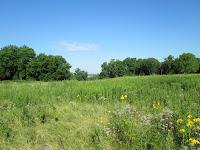Post contributed by Tyler Polster, Saint Paul's Seasonal Natural Resource Technician:
 |
| Highwood Nature Preserve |
While you are walking through a park, do you ever wonder what might be sharing the trail with you? Or what kind of secrets are happening that you can't even see? Recently, with the assistance and guidance of Carmen Martin from the
Bell Museum, we completed a small mammal survey at Highwood Nature Preserve to help us understand the biodiversity of one of our more scenic parks.
 |
| Northern Short-tailed Shrew |
Highwood Nature Preserve is approximately 13 acres. It overlooks Pigs Eye Lake, and on a good winter day with no leaves on the trees, you can see the skylines of both Minneapolis and Saint Paul in the distance. Portions of the park are currently being restored to a native prairie, which it once was. Prairies historically are very diverse habitats that can host a wide range of creatures and our goal was to find out what lives here!
To conduct our survey we used humane live traps baited with oatmeal and peanut butter. The smellier the bait is, the better! After four nights of trapping, our results didn't disappoint! We captured four species of mice, including a Meadow Jumping Mouse, which is not commonly caught in the area! Other species that we trapped include voles, moles, shrews, raccoons and gray squirrels. You can learn more about
Minnesota's small rodents from the Department of Natural Resources. In addition to trapping, we observed a number of additional species. This list includes deer, three species of bats, signs of fox, and red squirrels. These results were amazing! It tells us that this particular area is home to a complex food chain which in turn lets us know that this is good habitat. The newly restored prairie flowers attract bugs which help pollinate and make more flowers, the new flowers and plants make more seeds and micro habitats for bugs, the mice, voles and squirrels eat the seeds, and the bats and shrews eat the bugs. All of these smaller animals allow the foxes, coyotes, and predatory birds to thrive.
Next time you are in any park, take a couple minutes and look around and see what secrets you can uncover!




